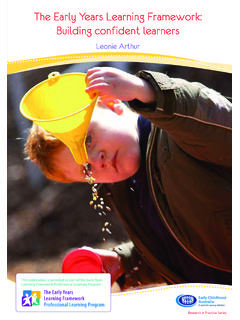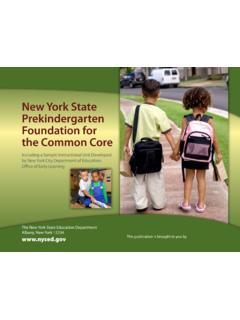Transcription of What children, birth to five, should know and be …
1 What children, birth to five, should know and be able to do Connecticut's early Learning and Development Standards were developed to help families, communities and schools work together to support children's early learning and growth. 1. April 2014. Photos taken at the Connecticut early childhood Block Party in Hartford's Bushnell Park on August 24, 2013, courtesy of Leah Grenier (cover photo and pages 4, 5, 6 and 10). CT ELDS logo design by Andrea Wadowski, Connecticut State Department of Education. Document design and layout by EASTCONN Communications, Hampton, Connecticut.
2 2. I am pleased to introduce the Connecticut early Learning and Development Standards (CT. ELDS) which serve as the foundation for supporting ALL young children in Connecticut, no matter where they live, play and learn. The CT ELDS are statements of what children from birth to age five should know and be able to do across the earliest years of development. The learning progressions within the Connecticut early Learning and Development Standards promote: Equity for all children, through the setting of high, but appropriate, expectations;. High-quality early learning experiences, by providing clear goals and trajectories of learning.
3 Provision of individual support, based on each child's growth and development;. Families' understanding of what their children are learning and how they can support them;. Teachers' understanding of age-appropriate content and approaches to children's learning;. and, Communication across sectors, based upon these common goals for children. The CT ELDS were developed through the work of the Connecticut early childhood Education Cabinet and its Learning Standards Workgroup. In addition, over 100 state and national experts participated in some way during the development process, helping to ensure a strong and comprehensive set of learning standards.
4 ALL CHILDREN, IN ALL SETTINGS, EVERY YEAR. Connecticut's vision is that all young children will have high-quality learning experiences, across all types of settings, and that children's growth and development will be supported across every year of their lives. The CT ELDS serve as a foundation for achieving this vision as they provide the basis for planning learning environments, supporting individual children and communicating around common goals. Myra Jones-Taylor, Executive Director, Connecticut Office of early childhood 3. Table of Contents Guiding 5-6.
5 Organization of the 7-9. Fostering Competent Learners Essential 10. Domain 11. Action Guides: What Can I Do to Support early Learning and Development?..pages 12-20. The early Learning and Development Standards 22-25. Social and Emotional 26-30. Physical Development and 31-34. Language and 35-40. Creative 41-43. 44-46. 47-49. Social 50-51. Dual Language Development 52-54. Appendix A: CT ELDS to Common Core State Standards Alignment 55-58. B: CT ELDS to Common Core State Standards Alignment 59-61. C: Connecticut early Learning & Development Standards (CT ELDS).
6 Development 62-64. D: CT early childhood Education Cabinet: early Learning Standards 65. E: Alignment, Drafting and Revision Process 66-67. F: 68-71. 4. Guiding Principles All children benefit from rich learning environments range at any point in time. All children within in homes, communities and early care and an age range should not be expected to gain education settings. Connecticut's early Learning a particular skill at the same time. Variation and Development Standards provide the basis for in the growth and development of skills and supporting children's growth and development across competencies applies to all young children settings.
7 The following principles guided the work on regardless of age, ability, developmental status the early learning and development standards. or special health care needs. Respect and support for individual differences in achieving The guiding principles are grouped into four broad learning outcomes should be a cornerstone of categories: Young Children, Families, early Learning early learning. Environments and Communities. The first category, g Develop and learn within the context of Young Children, addresses what is known about their family and culture.
8 Each child's family young children's learning and development. The and culture lays the foundation of who they other categories address the roles and responsibilities are and how they learn and grow. of families, early childhood environments and communities in supporting children's health, learning and development. These principles must be considered when this document is used to support children in any early learning environment. Although this document articulates learning standards for children from birth to age 5, these same principles apply throughout the early elementary years.
9 Young Children: g Are capable and competent. All children are capable of achieving positive early learning Families: g Are the primary caregivers and educators and developmental outcomes. There should be high expectations for all young children, of young children. Families lay the regardless of their background, experience, foundation for their children's success, language or developmental status. through their relationship with their children and by providing experiences that are critical g Learn best when their basic needs are met. for their children's growth and development.
10 Basic needs of young children include health (physical, mental and oral), safe and nurturing g Are critical partners in all early learning environments, positive social relationships, environments. It is important for families to a sense of belonging and sound nutrition. If be actively engaged with their child's early these basic needs are not met, a child's growth care and education. Ongoing communication and development will be affected. and an active partnership are necessary to ensure positive outcomes; therefore, families g Are unique in their growth and must be supported as partners in all early development.















